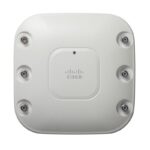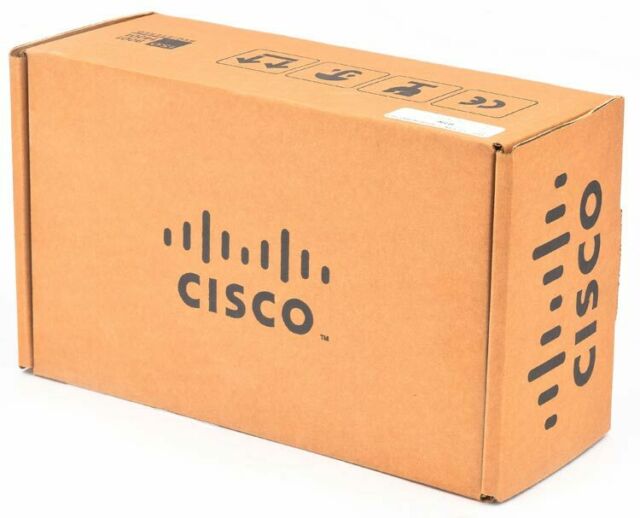

AIR-LAP1131AG-E-K9 Datasheet
$699.00
| Model: | AIR-LAP1131AG-E-K9 1130AG Series Access Points |
| Detail: | 802.11ag LWAPP AP Integrated Antennas ETSI Cnfg 1130AG Series Access Points |
PDF Attachment: AIR-LAP1131AG-E-K9 Datasheet
- Description
Description
The Cisco Aironet 1130AG Series is available in two versions: unified or autonomous. Unified access points operate with the Lightweight Access Point Protocol (LWAPP) and work in conjunction with Cisco wireless LAN controllers and the Cisco Wireless Control System (WCS).
When configured with LWAPP, the Cisco Aironet AIR-LAP1131AG-E-K9 can automatically detect the best-available Cisco wireless LAN controller and download appropriate policies and configuration information with no manual intervention.
We are committed to providing quality, reliable products to our customers and we have AIR-ANT2535SDW-R product is fully tested to factory specifications in our UAE, Dubai facility and backed with our lifetime warranty.
AIR-LAP1131AG-E-K9 Datasheet Specification |
||||||
| Part Number | AIR-LAP1131AG-E-K9 | |||||
| Product Description | 802.11ag LWAPP AP Integrated Antennas ETSI Cnfg 1130AG Series Access Points | |||||
| Software | • Cisco IOS Software Release 12.3(8)JA or later (autonomous).
• Cisco IOS Software Release 12.3(11)JX or later (Lightweight Mode). |
|||||
| Data Rates Supported | • 802.11a: 6, 9, 12, 18, 24, 36, 48, and 54 Mbps
• 802.11g: 1, 2, 5.5, 6, 9, 11, 12, 18, 24, 36, 48, and 54 Mbps |
|||||
| Network Standard | IEEE 802.11a, 802.11b, and 802.11g | |||||
| Uplink | Autosensing 802.3 10/100BASE-T Ethernet | |||||
| Frequency Band and Operating Channels | Americas (FCC)
• 2.412 to 2.462 GHz; 11 channels • 5.15 to 5.35, 5.725 to 5.825 GHz; 12 channels China • 2.412 to 2.472 GHz; 13 channels • 5.725 to 5.825 GHz; 4 channels ETSI • 2.412 to 2.472 GHz; 13 channels • 5.15 to 5.725 GHz; 19 channels Israel • 2.432 to 2.472 GHz; 9 channels • 5.15 to 5.35 GHz, 8 channels Japan (TELEC) • 2.412 to 2.472 GHz; 13 channels Orthogonal Frequency Division Multiplexing (OFDM) • 2.412 to 2.484 GHz; 14 channels Complementary Code Keying (CCK) • 5.15 to 5.25 GHz; 4 channels Japan-P (TELEC 2 (Japan2) Cnfg) • 2.412 to 2.472 GHz; 13 channels Orthogonal Frequency Division Multiplexing (OFDM) • 2.412 to 2.484 GHz; 14 channels Complementary Code Keying (CCK) • 5.15 to 5.35 GHz, 8 channels Japan-Q • 2.412 to 2.472 GHz; 13 channels Orthogonal Frequency Division Multiplexing (OFDM) • 2.412 to 2.484 GHz; 14 channels Complementary Code Keying (CCK) • 5.15 to 5.35 GHz, 8 channels • 5.470 to 5.725 GHz, 11 channels Korea • 2.412 to 2.472 GHz; 13 channels • 5.15 to 5.35, 5.46 to 5.72, 5.725 to 5.825, 19 channels North America • 2.412 to 2.462 GHz; 11 channels • 5.15 to 5.35, 5.725 to 5.825 GHz; 12 channels Singapore • 2.412 to 2.472 GHz, 13 channels • 5.15 to 5.35 GHz, 8 channels and 5.725 to 5.825 GHz, 12 channels Taiwan • 2.412 to 2.462 GHz, 11 channels • 5.25-5.35 GHz, 5.725 to 5.825, 7 channels |
|||||
| Nonoverlapping Channels | 802.11a: Up to 19 | 802.11b/g: 3 | ||||
| Receive Sensitivity (Typical) | 802.11a:
6 Mbps: -87 dBm 9 Mbps: -86 dBm 12 Mbps: -85 dBm 18 Mbps: -84 dBm 24 Mbps: -80 dBm 36 Mbps: -78 dBm 48 Mbps: -73 dBm 54 Mbps: -71 dBm |
802.11g:
1 Mbps: -93 dBm 2 Mbps: -91 dBm 5.5 Mbps: -88 dBm 6 Mbps: -86 dBm 9 Mbps: -85 dBm 11 Mbps: -85 dBm 12 Mbps: -84 dBm 18 Mbps: -83 dBm 24 Mbps: -79 dBm 36 Mbps: -77 dBm 48 Mbps: -72 dBm 54 Mbps: -70 dBm |
||||
| Available Transmit Power Settings (Maximum Power Setting Will Vary by Channel and According to Individual Country Regulations) | 802.11a:
OFDM: 17 dBm (50 mW) 15 dBm (30 mW) 14 dBm (25 mW) 11 dBm (12 mW) 8 dBm (6 mW) 5 dBm (3 mW) 2 mW (2 dBm) -1 dBm (1 mW) |
802.11b:
CCK: 20 dBm (100 mW) 17 dBm (50 mW) 14 dBm (25 mW) 11 dBm (12 mW) 8 dBm (6 mW) 5 dBm (3 mW) 2 dBm (2 mW) -1 dBm (1 mW) |
802.11g:
OFDM: 17 dBm (50 mW) 14 dBm (25 mW) 11 dBm (12 mW) 8 dBm (6 mW) 5 dBm (3 mW) 2 dBm (2 mW) -1 dBm (1 mW) |
|||
| Range | Indoor (Distance Across Open Office Environment): | Outdoor: | ||||
| 802.11a:
80 ft (24 m) @ 54 Mbps 150 ft (45 m) @ 48 Mbps 200 ft (60 m) @ 36 Mbps 225 ft (69 m) @ 24 Mbps 250 ft (76 m) @ 18 Mbps 275 ft (84 m) @ 12 Mbps 300 ft (91 m) @ 9 Mbps 325 ft (100 m) @ 6 Mbps |
802.11g:
100 ft (30 m) @ 54 Mbps 175 ft (53 m) @ 48 Mbps 250 ft (76 m) @ 36 Mbps 275 ft (84 m) @ 24 Mbps 325 ft (100 m) @ 18 Mbps 350 ft (107 m) @ 12 Mbps 360 ft (110 m) @ 11 Mbps 375 ft (114 m) @ 9 Mbps 400 ft (122 m) @ 6 Mbps 420 ft (128 m) @ 5.5 Mbps 440 ft (134 m) @ 2 Mbps 450 ft (137 m) @ 1 Mbps |
802.11a:
100 ft (30 m) @ 54 Mbps 300 ft (91 m) @ 48 Mbps 425 ft (130 m) @ 36 Mbps 500 ft (152 m) @ 24 Mbps 550 ft (168 m) @ 18 Mbps 600 ft (183 m) @ 12 Mbps 625 ft (190 m) @ 9 Mbps 650 ft (198 m) @ 6 Mbps |
802.11g:
120 ft (37 m) @ 54 Mbps 350 ft (107 m) @ 48 Mbps 550 ft (168 m) @ 36 Mbps 650 ft (198 m) @ 24 Mbps 750 ft (229 m) @ 18 Mbps 800 ft (244 m) @ 12 Mbps 820 ft (250 m) @ 11 Mbps 875 ft (267 m) @ 9 Mbps 900 ft (274 m) @ 6 Mbps 910 ft (277 m) @ 5.5 Mbps 940 ft (287 m) @ 2 Mbps 950 ft (290 m) @ 1 Mbps |
|||
| Ranges and actual throughput vary based upon numerous environmental factors so individual performance may differ. | ||||||
| Compliance | Standards
Safety • UL 60950-1 • CAN/CSA-C22.2 No. 60950-1 • UL 2043 • IEC 60950-1 • EN 60950-1 • NIST FIPS 140-2 level 2 validation Radio Approvals • FCC Part 15.247, 15.407 • RSS-210 (Canada) • EN 300.328, EN 301.893 (Europe) • ARIB-STD 33 (Japan) • ARIB-STD 66 (Japan) • ARIB-STD T71 (Japan) • AS/NZS 4268.2003 (Australia and New Zealand) EMI and Susceptibility (Class B) • FCC Part 15.107 and 15.109 • ICES-003 (Canada) • VCCI (Japan) • EN 301.489-1 and -17 (Europe) Security • 802.11i, WPA2, WPA • 802.1X • AES, TKIP • FIPS 140-2 Pre-Validation List • Common Criteria (when running Cisco IOS software) Other • IEEE 802.11g and IEEE 802.11a • FCC Bulletin OET-65C • RSS-102 |
|||||
| Antennas | • 2.4 GHz
• Gain 3.0 dBi • Horizontal Beamwidth 360° • 5 GHz • Gain 4.5 dBi • Horizontal Beamwidth 360° |
|||||
| Security | Authentication
Security Standards • WPA • WPA2 (802.11i) • Cisco TKIP • Cisco message integrity check (MIC) • IEEE 802.11 WEP keys of 40 bits and 128 bits 802.1X EAP types: • EAP-Flexible Authentication via Secure Tunneling (EAP-FAST) • Protected EAP-Generic Token Card (PEAP-GTC) • PEAP-Microsoft Challenge Authentication Protocol Version 2 (PEAP-MSCHAP) • EAP-Transport Layer Security (EAP-TLS) • EAP-Tunneled TLS (EAP-TTLS) • EAP-Subscriber Identity Module (EAP-SIM) • Cisco LEAP Encryption • AES-CCMP encryption (WPA2) • TKIP (WPA) • Cisco TKIP • WPA TKIP • IEEE 802.11 WEP keys of 40 bits and 128 bits |
|||||
| Status LEDs | External:
• Status LED indicates operating state, association status, error/warning condition, boot sequence, and maintenance status Internal: • Ethernet LED indicates activity over the Ethernet, status • Radio LED indicates activity over the radios, status |
|||||
| Dimensions (H x W x D) | 7.5 in. x 7.5 in. x 1.3 in. (19.1 x 19.1 x 3.3 cm) | |||||
| Weight | 1.5 lb (0.67 kg) | |||||
| Environmental | Operating
• Altitude: 0 to 2500m • 32 to 104°F (0 to 40°C) • 10 to 90% humidity (noncondensing) Non Operating • -40 to 158F (-40 to 70C) • Up to 95% humidity (noncondensing) |
|||||
| System Memory | • 32 MB RAM
• 16 MB FLASH |
|||||
| Input Power Requirements | • 100-240 VAC; 50-60Hz (power supply)
• 36-57 VDC (device) |
|||||
| Power Draw | 12.2W maximum | |||||





